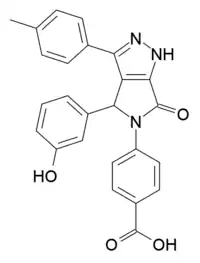CID16020046
CID16020046 is a compound which acts as an inverse agonist at the former orphan receptor GPR55,[1] and may be the first selective inverse agonist characterised for this receptor. It was found to block a number of GPR55 mediated responses such as wound healing and activation of immune system T-cells and B-cells, as well as showing inverse agonist activity in the absence of GPR55 agonist stimulation. However while it was found to have good selectivity over the related CB1 and CB2 cannabinoid receptors as well as a number of other targets, CID16020046 has not yet been tested against another related receptor GPR18, so its selectivity for GPR55 over this target has not been established.[2] It has antiinflammatory actions,[3][4][5] has been used to study the interaction between GPR55 mediated and CB1 mediated activity,[6] and research using this compound has revealed a role for GPR55 in learning and memory.[7][8]
 | |
| Identifiers | |
|---|---|
| |
| CAS Number | |
| PubChem CID | |
| IUPHAR/BPS | |
| ChemSpider | |
| UNII | |
| ECHA InfoCard | 100.233.214 |
| Chemical and physical data | |
| Formula | C25H19N3O4 |
| Molar mass | 425.435 g·mol−1 |
| 3D model (JSmol) | |
| |
| |
See also
References
- Brown AJ, Castellano-Pellicena I, Haslam CP, Nichols PL, Dowell SJ (2018). "Structure-Activity Relationship of the GPR55 Antagonist, CID16020046". Pharmacology. 102 (5–6): 324–331. doi:10.1159/000493490. PMID 30296786. S2CID 52938892.
- Kargl J, Brown AJ, Andersen L, Dorn G, Schicho R, Waldhoer M, Heinemann A (July 2013). "A selective antagonist reveals a potential role of G protein-coupled receptor 55 in platelet and endothelial cell function". The Journal of Pharmacology and Experimental Therapeutics. 346 (1): 54–66. doi:10.1124/jpet.113.204180. PMID 23639801. S2CID 17801.
- Stančić A, Jandl K, Hasenöhrl C, Reichmann F, Marsche G, Schuligoi R, Heinemann A, Storr M, Schicho R (October 2015). "The GPR55 antagonist CID16020046 protects against intestinal inflammation". Neurogastroenterology and Motility. 27 (10): 1432–45. doi:10.1111/nmo.12639. PMC 4587547. PMID 26227635.
- Montecucco F, Bondarenko AI, Lenglet S, Burger F, Piscitelli F, Carbone F, et al. (October 2016). "Treatment with the GPR55 antagonist CID16020046 increases neutrophil activation in mouse atherogenesis". Thrombosis and Haemostasis. 116 (5): 987–997. doi:10.1160/TH16-02-0139. PMID 27465665.
- Wang Y, Pan W, Wang Y, Yin Y (March 2020). "The GPR55 antagonist CID16020046 protects against ox-LDL-induced inflammation in human aortic endothelial cells (HAECs)". Archives of Biochemistry and Biophysics. 681: 108254. doi:10.1016/j.abb.2020.108254. PMID 31904362. S2CID 209895392.
- Wang XF, Galaj E, Bi GH, Zhang C, He Y, Zhan J, et al. (April 2020). "2 versus GPR55 receptors". British Journal of Pharmacology. 177 (8): 1865–1880. doi:10.1111/bph.14958. PMC 7070166. PMID 31877572.
- Marichal-Cancino BA, Sánchez-Fuentes A, Méndez-Díaz M, Ruiz-Contreras AE, Prospéro-García O (June 2016). "Blockade of GPR55 in the dorsolateral striatum impairs performance of rats in a T-maze paradigm". Behavioural Pharmacology. 27 (4): 393–6. doi:10.1097/FBP.0000000000000185. PMID 26292188. S2CID 3627821.
- Hurst K, Badgley C, Ellsworth T, Bell S, Friend L, Prince B, Welch J, Cowan Z, Williamson R, Lyon C, Anderson B, Poole B, Christensen M, McNeil M, Call J, Edwards JG (September 2017). "A putative lysophosphatidylinositol receptor GPR55 modulates hippocampal synaptic plasticity". Hippocampus. 27 (9): 985–998. doi:10.1002/hipo.22747. PMC 5568947. PMID 28653801.